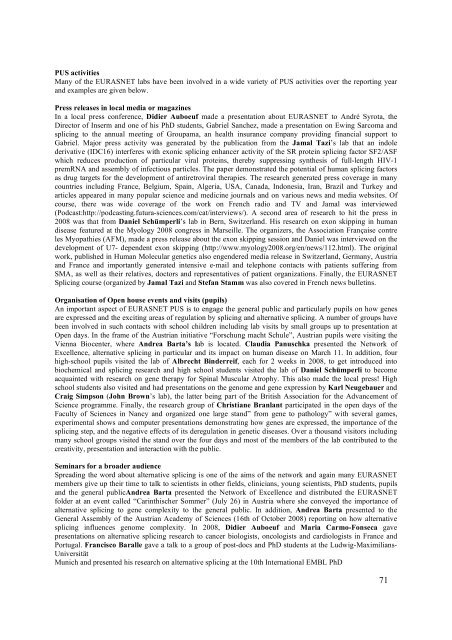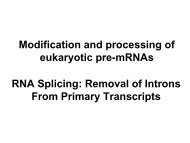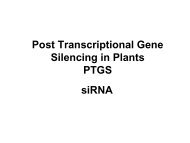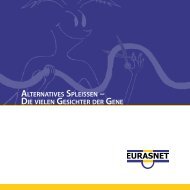Create successful ePaper yourself
Turn your PDF publications into a flip-book with our unique Google optimized e-Paper software.
PUS activitiesMany of the <strong>EURASNET</strong> labs have been involved in a wide variety of PUS activities over the reporting yearand examples are given below.Press releases in local media or magazinesIn a local press conference, Didier Auboeuf made a presentation about <strong>EURASNET</strong> to André Syrota, theDirector of Inserm and one of his PhD students, Gabriel Sanchez, made a presentation on Ewing Sarcoma andsplicing to the annual meeting of Groupama, an health insurance company providing financial support toGabriel. Major press activity was generated by the publication from the Jamal Tazi’s lab that an indolederivative (IDC16) interferes with exonic splicing enhancer activity of the SR protein splicing factor SF2/ASFwhich reduces production of particular viral proteins, thereby suppressing synthesis of full-length HIV-1premRNA and assembly of infectious particles. The paper demonstrated the potential of human splicing factorsas drug targets for the development of antiretroviral therapies. The research generated press coverage in manycountries including France, Belgium, Spain, Algeria, USA, Canada, Indonesia, Iran, Brazil and Turkey andarticles appeared in many popular science and medicine journals and on various news and media websites. Ofcourse, there was wide coverage of the work on French radio and TV and Jamal was interviewed(Podcast:http://podcasting.futura-sciences.com/cat/interviews/). A second area of research to hit the press in<strong>2008</strong> was that from Daniel Schümperli’s lab in Bern, Switzerland. His research on exon skipping in humandisease featured at the Myology <strong>2008</strong> congress in Marseille. The organizers, the Association Française contreles Myopathies (AFM), made a press release about the exon skipping session and Daniel was interviewed on thedevelopment of U7- dependent exon skipping (http://www.myology<strong>2008</strong>.org/en/news/112.html). The originalwork, published in Human Molecular genetics also engendered media release in Switzerland, Germany, Austriaand France and importantly generated intensive e-mail and telephone contacts with patients suffering fromSMA, as well as their relatives, doctors and representatives of patient organizations. Finally, the <strong>EURASNET</strong>Splicing course (organized by Jamal Tazi and Stefan Stamm was also covered in French news bulletins.Organisation of Open house events and visits (pupils)An important aspect of <strong>EURASNET</strong> PUS is to engage the general public and particularly pupils on how genesare expressed and the exciting areas of regulation by splicing and alternative splicing. A number of groups havebeen involved in such contacts with school children including lab visits by small groups up to presentation atOpen days. In the frame of the Austrian initiative “Forschung macht Schule”, Austrian pupils were visiting theVienna Biocenter, where Andrea Barta’s lab is located. Claudia Panuschka presented the Network ofExcellence, alternative splicing in particular and its impact on human disease on March 11. In addition, fourhigh-school pupils visited the lab of Albrecht Binderreif, each for 2 weeks in <strong>2008</strong>, to get introduced intobiochemical and splicing research and high school students visited the lab of Daniel Schümperli to becomeacquainted with research on gene therapy for Spinal Muscular Atrophy. This also made the local press! Highschool students also visited and had presentations on the genome and gene expression by Karl Neugebauer andCraig Simpson (John Brown’s lab), the latter being part of the British Association for the Advancement ofScience programme. Finally, the research group of Christiane Branlant participated in the open days of theFaculty of Sciences in Nancy and organized one large stand” from gene to pathology” with several games,experimental shows and computer presentations demonstrating how genes are expressed, the importance of thesplicing step, and the negative effects of its deregulation in genetic diseases. Over a thousand visitors includingmany school groups visited the stand over the four days and most of the members of the lab contributed to thecreativity, presentation and interaction with the public.Seminars for a broader audienceSpreading the word about alternative splicing is one of the aims of the network and again many <strong>EURASNET</strong>members give up their time to talk to scientists in other fields, clinicians, young scientists, PhD students, pupilsand the general publicAndrea Barta presented the Network of Excellence and distributed the <strong>EURASNET</strong>folder at an event called “Carinthischer Sommer” (July 26) in Austria where she conveyed the importance ofalternative splicing to gene complexity to the general public. In addition, Andrea Barta presented to theGeneral Assembly of the Austrian Academy of Sciences (16th of October <strong>2008</strong>) reporting on how alternativesplicing influences genome complexity. In <strong>2008</strong>, Didier Auboeuf and Maria Carmo-Fonseca gavepresentations on alternative splicing research to cancer biologists, oncologists and cardiologists in France andPortugal. Francisco Baralle gave a talk to a group of post-docs and PhD students at the Ludwig-Maximilians-UniversitätMunich and presented his research on alternative splicing at the 10th International EMBL PhD71







